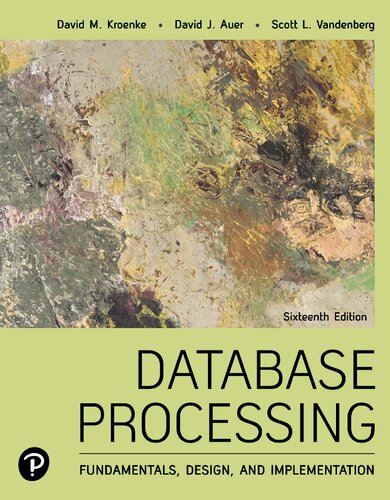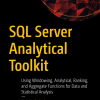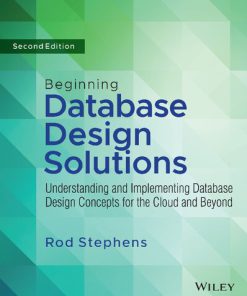Database Processing Fundamentals Design and Implementation 16th Edition by David Kroenke, David Auer, Scott Vandenberg, Robert Yoder 0136930093 9780136930099
$50.00 Original price was: $50.00.$25.00Current price is: $25.00.
Database Processing Fundamentals Design and Implementation 16th Edition by David Kroenke, David Auer, Scott Vandenberg, Robert Yoder – Ebook PDF Instant Download/Delivery: 0136930093, 9780136930099
Full download Database Processing Fundamentals Design and Implementation 16th Edition after payment

Product details:
ISBN 10: 0136930093
ISBN 13: 9780136930099
Author: David M. Kroenke; David J. Auer; Scott L. Vandenberg; Robert C. Yoder
Getting straight to the point of database processing Database Processing: Fundamentals, Design, and Implementation,16th Edition, is a thorough and modern look at database processing fundamentals that’s designed to get straight to the point. The 16th edition refines the organization and content of this classic textbook to reflect a new teaching and professional workplace environment. It also addresses the latest software and expands upon new and emerging developments in the database processing field.
Database Processing Fundamentals Design and Implementation 16th Table of contents:
- Database Processing Fundamentals, Design, and Implementation
- Brief Contents
- Contents
- Foreword to the 40th Anniversary Edition
- Preface
- New to This Edition
- Fundamentals, Design, and Implementation
- Focus on Database Application Processing
- Business Intelligence Systems and Dimensional Databases
- Overview of the Chapters in the 16th Edition
- Supplements
- About the Authors
- Work Experience
- Consulting
- Publications
- Teaching
- Education
- Personal
- Work Experience
- Publications
- Teaching
- Education
- Personal
- Work Experience
- Publications
- Teaching
- Education
- Personal
- Part 1 Getting Started
- 1 Introduction
- Chapter Objectives
- The Importance of Databases in the Internet and Mobile App World
- The Characteristics of Relational Databases
- A Note on Naming Conventions
- A Database Has Data and Relationships
- Databases Create Information
- Database Examples
- Single-User Database Applications
- Multiuser Database Applications
- E-Commerce Database Applications
- Reporting and Data Mining Database Applications
- The Components of a Database System
- Database Applications and SQL
- The DBMS
- The Database
- Personal Versus Enterprise-Class Database Systems
- What Is Microsoft Access?
- What Is an Enterprise-Class Database System?
- Database Applications in an Enterprise-Class Database System
- The DBMS in an Enterprise-Class Database System
- Microsoft SQL Server 2019
- Oracle Database
- MySQL 8.0
- Database Design
- Database Design from Existing Data
- Database Design for New Systems Development
- Database Redesign
- What You Need to Learn
- A Brief History of Database Processing
- The Early Years
- The Emergence and Dominance of the Relational Model
- Post-Relational Developments
- Summary
- Key Terms
- Review Questions
- Exercises
- 2 Introduction to Structured Query Language
- Chapter Objectives
- Cape Codd Outdoor Sports
- Business Intelligence Systems and Data Warehouses
- The Cape Codd Outdoor Sports Extracted Retail Sales Data Database
- The RETAIL_ORDER Table
- The ORDER_ITEM Table
- The SKU_DATA Table
- The BUYER Table
- The CATALOG_SKU_20## Tables
- The Complete Cape Codd Data Extract Schema
- Data Extracts Are Common
- SQL Background
- The SQL SELECT/FROM/WHERE Framework
- Reading Specified Columns from a Single Table
- Specifying Column Order in SQL Queries from a Single Table
- Submitting SQL Statements to the DBMS
- Using SQL in Microsoft Access 2019
- Does Not Work with Microsoft Access ANSI-89 SQL
- Processing SQL Statements in Microsoft Access 2019
- Using SQL in Microsoft SQL Server 2019
- Using SQL in Oracle Database
- Using SQL in Oracle MySQL 8.0
- SQL Enhancements for Querying a Single Table
- Reading Specified Rows from a Single Table
- Reading Specified Columns and Rows from a Single Table
- Sorting the SQL Query Results
- SQL WHERE Clause Options
- Compound SQL WHERE Clauses Using Logical Operators
- SQL WHERE Clauses Using Sets of Values
- SQL WHERE Clauses Using Ranges of Values
- SQL WHERE Clauses That Use Character String Patterns
- SQL WHERE Clauses That Use NULL Values
- Performing Calculations in SQL Queries
- Using SQL Built-in Aggregate Functions
- SQL Expressions in SQL SELECT Statements
- Grouping Rows in SQL SELECT Statements
- Querying Two or More Tables with SQL
- Querying Multiple Tables with Subqueries
- Querying Multiple Tables with Joins
- Comparing Subqueries and Joins
- The SQL JOIN ON Syntax
- SQL Queries on Recursive Relationships
- Outer Joins
- Using SQL Set Operators
- Summary
- Key Terms
- Review Questions
- Exercises
- Case Questions
- Marcia’s Dry Cleaning Case Questions
- The Queen Anne Curiosity Shop Project Questions
- Morgan Importing Project Questions
- Part 2 Database Design
- 3 The Relational Model and Normalization
- Chapter Objectives
- Relational Model Terminology
- Relations
- Characteristics of Relations
- Alternative Terminology
- To Key or Not to Key—That Is the Question!
- Functional Dependencies
- Functional Dependencies That Are Not Equations
- Composite Functional Dependencies
- Finding Functional Dependencies
- Functional Dependencies in the SKU_DATA Table
- Functional Dependencies in the ORDER_ITEM Table
- When Are Determinant Values Unique?
- Keys
- Candidate Keys
- Primary Keys
- Surrogate Keys
- Foreign Keys
- Normal Forms
- Modification Anomalies
- A Short History of Normal Forms
- Normalization Categories
- From First Normal Form to Boyce-Codd Normal Form Step-by-Step
- Second Normal Form
- Third Normal Form
- Boyce-Codd Normal Form
- Eliminating Anomalies from Functional Dependencies with BCNF
- Normalization Example 1
- Normalization Example 1: The “Step-by-Step” Method
- Normalization Example 1: The “Straight-to-BCNF” Method
- Normalization Example 2
- Normalization Example 3
- Normalization Example 4
- Normalization Example 5
- Eliminating Anomalies from Multivalued Dependencies
- Fifth Normal Form
- Domain/Key Normal Form
- Summary
- Key Terms
- Review Questions
- Exercises
- Case Questions
- Regional Labs Case Questions
- The Queen Anne Curiosity Shop Project Questions
- Morgan Importing Project Questions
- 4 Database Design Using Normalization
- Chapter Objectives
- Assess Table Structure
- Designing Updatable Databases
- Advantages and Disadvantages of Normalization
- Functional Dependencies
- Normalizing with SQL
- Choosing Not to Use BCNF
- Multivalued Dependencies
- Designing Read-Only Databases
- Denormalization
- Customized Duplicated Tables
- Common Design Problems
- The Multivalue, Multicolumn Problem
- Inconsistent Values
- Missing Values
- The General-Purpose Remarks Column
- Summary
- Key Terms
- Review Questions
- Exercises
- Case Questions
- Marcia’s Dry Cleaning Case Questions
- The Queen Anne Curiosity Shop Project Questions
- Morgan Importing Project Questions
- 5 Data Modeling with the Entity-Relationship Model
- Chapter Objectives
- The Purpose of a Data Model
- The Entity-Relationship Model
- Entities
- Attributes
- Identifiers
- Relationships
- Maximum Cardinality
- Minimum Cardinality
- Entity-Relationship Diagrams and Their Versions
- Variations of the E-R Model
- E-R Diagrams Using the IE Crow’s Foot Model
- Strong Entities and Weak Entities
- ID-Dependent Entities
- Non-ID-Dependent Weak Entities
- The Ambiguity of the Weak Entity
- Subtype Entities
- Patterns in Forms, Reports, and E-R Models
- Strong Entity Relationship Patterns
- 1:1 Strong Entity Relationships
- 1:N Strong Entity Relationships
- N:M Strong Entity Relationships
- ID-Dependent Relationship Patterns
- The Association Pattern and the Associative Entity
- The Multivalued Attribute Pattern
- The Archetype/Instance Pattern
- Mixed Identifying and Nonidentifying Relationship Patterns
- The Line-Item Pattern
- Other Mixed Relationship Patterns
- The For-Use-By Subtype Pattern
- Recursive Relationship Patterns
- 1:1 Recursive Relationships
- 1:N Recursive Relationships
- N:M Recursive Relationships
- The Data Modeling Process
- The College Report
- The Department Report
- The Department/Major Report
- The Student Acceptance Letter
- Summary
- Key Terms
- Review Questions
- Exercises
- Case Questions
- Writer’s Patrol Case Questions
- Highline University Mentor Program Case Questions
- The Queen Anne Curiosity Shop Project Questions
- Morgan Importing Project Questions
- 6 Transforming Data Models into Database Designs
- Chapter Objectives
- The Purpose of a Database Design
- Create a Table for Each Entity
- Selecting the Primary Key
- Specifying Alternate Keys
- Specifying Column Properties
- Null Status
- Data Type
- Default Value
- Data Constraints
- Verify Normalization
- Create Relationships
- Relationships Between Strong Entities
- 1:1 Relationships Between Strong Entities
- 1:N Relationships Between Strong Entities
- N:M Relationships Between Strong Entities
- Relationships Using ID-Dependent Entities
- Association Relationships
- Multivalued Attributes
- Archetype/Instance Pattern
- Relationships with a Weak Non-ID-Dependent Entity
- Relationships in Mixed Entity Designs
- Relationships Between Supertype and Subtype Entities
- Recursive Relationships
- 1:1 Recursive Relationships
- 1:N Recursive Relationships
- N:M Recursive Relationships
- Representing Ternary and Higher-Order Relationships
- Relational Representation of the Highline University Data Model
- Design for Minimum Cardinality
- Actions When the Parent Is Required
- Actions on the Parent Row when the Parent Is Required
- Actions on the Child Row When the Parent Is Required
- Actions When the Child Is Required
- Actions on the Parent Row When the Child Is Required
- Actions on the Child Row When the Child Is Required
- Implementing Actions for M-O Relationships
- Implementing Actions for O-M Relationships
- Implementing Actions for M-M Relationships
- Designing Special Case M-M Relationships
- Documenting the Minimum Cardinality Design
- Documenting Required Parents
- Documenting Required Children
- An Additional Complication
- Summary of Minimum Cardinality Design
- The View Ridge Gallery Database
- View Ridge Gallery Database Summary of Requirements
- The View Ridge Data Model
- Database Design with Data Keys
- Surrogate Key Database Design
- Minimum Cardinality Enforcement for Required Parents
- Minimum Cardinality Enforcement for the Required Child
- Column Properties for the View Ridge Database Design Tables
- Summary
- Key Terms
- Review Questions
- Exercises
- Case Questions
- Writer’s Patrol Case Questions
- San Juan Sailboat Charters Case Questions
- The Queen Anne Curiosity Shop Project Questions
- Morgan Importing Project Questions
- Part 3 Database Implementation
- 7 SQL for Database Construction and Application Processing
- Chapter Objectives
- The Importance of Working with an Installed DBMS Product
- The View Ridge Gallery Database
- SQL DDL and DML
- Managing Table Structure with SQL DDL
- Creating the VRG Database
- Using SQL Scripts
- Using the SQL CREATE TABLE Statement
- Variations in SQL Data Types and SQL/PSM
- Creating the VRG Database ARTIST Table
- Creating the VRG Database WORK Table and the 1:N ARTIST-to-WORK Relationship
- Implementing Required Parent Rows
- Implementing 1:1 Relationships
- Casual Relationships
- Creating Default Values and Data Constraints with SQL
- Implementing Default Values
- Implementing Data Constraints
- Creating the VRG Database Tables
- The SQL ALTER TABLE Statement
- Adding and Dropping Columns
- Adding and Dropping Constraints
- The SQL DROP TABLE Statement
- The SQL TRUNCATE TABLE Statement
- The SQL CREATE INDEX Statement
- SQL DML Statements
- The SQL INSERT Statement
- The SQL INSERT Statement Using Column Names
- Bulk INSERT
- Populating the VRG Database Tables
- The SQL UPDATE Statement
- Bulk Updates
- Updating Using Values from Other Tables
- The SQL MERGE Statement
- The SQL DELETE Statement
- Using SQL Views
- Using SQL Views to Hide Columns and Rows
- Using SQL Views to Display Results of Computed Columns
- Using SQL Views to Hide Complicated SQL Syntax
- Layering Built-in Functions
- Using SQL Views for Isolation, Multiple Permissions, and Multiple Triggers
- Updating SQL Views
- Embedding SQL in Program Code
- SQL/Persistent Stored Modules (SQL/PSM)
- Using SQL User-Defined Functions
- Using SQL Triggers
- Using Triggers to Provide Default Values
- Using Triggers to Enforce Data Constraints
- Using Triggers to Update Views
- Using Triggers to Implement Referential Integrity Actions
- Using Stored Procedures
- Advantages of Stored Procedures
- The WORK_AddWorkTransaction Stored Procedure
- Comparing User-Defined Functions, Triggers, and Stored Procedures
- Summary
- Key Terms
- Review Questions
- Wedgewood Pacific Review Questions
- Exercises
- Wedgewood Pacific Exercises
- Case Questions
- Heather Sweeney Designs Case Questions
- The Queen Anne Curiosity Shop Project Questions
- Morgan Importing Project Questions
- 8 Database Redesign
- Chapter Objectives
- The Need for Database Redesign
- SQL Statements for Checking Functional Dependencies
- What Is a Correlated Subquery?
- Searching for Multiple Rows with a Given Title
- A Correlated Subquery that Finds Rows with the Same Title
- What Is the Difference Between Regular and Correlated Subqueries?
- A Common Trap
- Using Correlated Subqueries to Check Functional Dependencies
- SQL Correlated Subqueries Using the EXISTS and NOT EXISTS Comparison Operators
- Using NOT EXISTS in a Double Negative
- The Double NOT EXISTS Query
- How Do I Analyze an Existing Database?
- Reverse Engineering
- Dependency Graphs
- Database Backup and Test Databases
- Changing Table Names and Table Columns
- Changing Table Names
- Adding and Dropping Columns
- Adding NOT NULL Columns
- Dropping Columns
- Changing a Column Data Type or Column Constraints
- Adding and Dropping Constraints
- Changing Relationship Cardinalities
- Changing Minimum Cardinalities
- Changing Minimum Cardinalities on the Parent Side
- Changing Minimum Cardinalities on the Child Side
- Changing Maximum Cardinalities
- Changing a 1:1 Relationship to a 1:N Relationship
- Changing a 1:N Relationship to an N:M Relationship
- Reducing Cardinalities (with Data Loss)
- Adding and Deleting Tables and Relationships
- Forward Engineering
- Summary
- Key Terms
- Review Questions
- Exercises
- Case Questions
- Marcia’s Dry Cleaning Case Questions
- The Queen Anne Curiosity Shop Project Questions
- Morgan Importing Project Questions
- Part 4 Enterprise Database Processing
- 9 Managing Enterprise Databases
- Chapter Objectives
- The Importance of Working with an Installed DBMS Product
- Database Administration
- Managing the Database Structure
- Configuration Control
- Documentation
- Physical Database Design and Optimization
- Concurrency Control
- The Need for Atomic Transactions
- Concurrent Transaction Processing
- The Lost Update Problem
- Resource Locking
- Lock Terminology
- Serializable Transactions
- Deadlock
- Optimistic Versus Pessimistic Locking
- SQL Transaction Control Language and Declaring Lock Characteristics
- Implicit and Explicit COMMIT TRANSACTION
- Consistent Transactions
- Transaction Isolation Level
- SQL Cursors
- Database Security
- Processing Rights and Responsibilities
- DBMS Security
- DBMS Security Guidelines
- Application Security
- The SQL Injection Attack
- Database Backup and Recovery
- Recovery via Reprocessing
- Recovery via Rollback/Rollforward
- Managing the DBMS
- Maintaining the Data Repository
- Summary
- Key Terms
- Review Questions
- Exercises
- Case Questions
- Marcia’s Dry Cleaning Case Questions
- The Queen Anne Curiosity Shop Project Questions
- Morgan Importing Project Questions
- 10 Managing Databases with Microsoft SQL Server 2019, Oracle Database, MySQL 8.0, and ArangoDB
- Chapter Objectives
- Installing the DBMS
- Using the DBMS in the Cloud
- Using the DBMS Database Administration and Database Development Utilities
- Creating a Database
- Creating and Running SQL Scripts
- Reviewing the Database Structure in the DBMS GUI Utility
- Creating and Populating the View Ridge Gallery VRG Database Tables
- Creating SQL Views for the View Ridge Gallery VRG Database
- Importing Microsoft Excel Data into a Database Table
- Database Application Logic and SQL/Persistent Stored Modules (SQL/PSM)
- DBMS Concurrency Control
- DBMS Security
- DBMS Database Backup and Recovery
- Other DBMS Topics Not Discussed
- Choose Your DBMS Product(s)!
- Summary
- Key Terms
- Exercises
- Part 5 Database Access Standards and Technology
- 11 The Web Server Environment
- Chapter Objectives
- A Web Database Application for the View Ridge Gallery
- Before You Read the Rest of Chapter!
- The Web Database Processing Environment
- Database Server Access Standards
- The ODBC Standard
- ODBC Architecture
- Conformance Levels
- ODBC Conformance Level
- SQL Conformance Level
- Creating an ODBC Data Source Name
- The Microsoft .NET Framework and ADO.NET
- OLE DB
- Goals of OLE DB
- OLE DB Terminology
- ADO and ADO.NET
- The ADO.NET Object Model
- The Java Platform
- JDBC
- Driver Types
- Using JDBC
- Java Server Pages (JSP) and Servlets
- Apache Tomcat
- Web Database Processing with PHP
- Web Database Processing with PHP and the NetBeans IDE
- Getting Started with HTML Web Pages
- The index.html Web Page
- Creating the index.html Web Page
- Using PHP
- The PHP Scripting Language
- The NetBeans Integrated Development Environment (IDE)
- The ReadArtist.php File
- Creating a Connection to the Database
- Creating a RecordSet
- Displaying the Results
- Disconnecting from the Database
- Web Page Examples with PHP
- Example 1: Updating a Table
- Example 2: Using PHP Data Objects (PDO)
- Example 3: Invoking a Stored Procedure
- Challenges for Web Database Processing
- SQL Injection Attacks
- Extensible Markup Language (XML)
- The Importance of XML
- XML as a Markup Language
- Creating XML Documents from Database Data
- Using the SQL SELECT . . . FOR XML Statement
- Summary
- Key Terms
- Review Questions
- Exercises
- Case Questions
- Marcia’s Dry Cleaning Case Question
- The Queen Anne Curiosity Shop Project Questions
- Morgan Importing Project Questions
- 12 Data Warehouses and Business Intelligence Systems
- Chapter Objectives
- Business Intelligence Systems
- The Relationship Between Operational and BI Systems
- Reporting Systems and Data Mining Applications
- Reporting Systems
- Data Mining Applications
- Data Warehouses and Data Marts
- Problems with Operational Data
- Components of a Data Warehouse
- Purchasing Data from Vendors
- Data Warehouses Versus Data Marts
- Dimensional Databases
- The Star Schema
- Illustrating the Dimensional Model
- Multiple Fact Tables and Conformed Dimensions
- Reporting Systems
- RFM Analysis
- Producing the RFM Report
- OLAP
- Reporting System Components
- Report Types
- Report Media
- Report Modes
- Reporting System Functions
- Report Authoring
- Report Management
- Report Delivery
- Data Mining
- Unsupervised Versus Supervised Data Mining
- Unsupervised Data Mining
- Supervised Data Mining
- Four Popular Data Mining Techniques
- Market Basket Analysis
- Decision Trees
- Summary
- Key Terms
- Review Questions
- Exercises
- Case Questions
- Marcia’s Dry Cleaning
- The Queen Anne Curiosity Shop Project Questions
- Morgan Importing Project Questions
- 13 Big Data, NoSQL, and the Cloud
- Chapter Objectives
- What Is Big Data?
- The Three Vs Plus One
- Volume
- Velocity
- Variety
- Veracity
- Big Data and NoSQL Systems
- The CAP Theorem
- Distributed Database Processing
- Types of Distributed Databases
- Challenges of Distributed Databases
- Object-Relational Databases
- Big Data Processing Models
- MapReduce
- Hadoop
- Non-Relational Database Management Systems
- Key-Value Databases
- Document Databases
- Column Family Databases
- Graph Databases
- Virtualization
- Cloud Computing
- Using a Cloud Database Management System
- Connecting to Microsoft Azure
- Creating a New SQL Database
- Setting Up Our Database Server Firewall Rules
- Migrating Our Existing Local HSD_DW Database to Azure
- Creating a New Relational Database on Microsoft Azure
- Creating and Using a NoSQL Document Database in Azure
- Cloud Reflections
- Big Data, NoSQL Systems, and the Future
- Summary
- Key Terms
- Review Questions
- Exercises
- Case Questions
- Marcia’s Dry Cleaning
- The Queen Anne Curiosity Shop Project Questions
- Morgan Importing Project Questions
- Online Appendices
- Bibliography
- Glossary
- Index
- Symbols
People also search for Database Processing Fundamentals Design and Implementation 16th:
what is database implementation
what is database fundamentals
role of database designer
database design fundamentals
Tags:
David Kroenke,David Auer,Scott Vandenberg,Robert Yoder,Database Processing,Fundamentals Design,Implementation
You may also like…
Computers - Databases
Data Base Processing Fundamentals, Design, and Implementation 15th Edition David M. Kroenke
Business & Economics - Others
Business & Economics - Management & Leadership
Computers - Databases
Reference - Library & Information Science
Education Studies & Teaching - Studying & Test Preparation
Uncategorized











